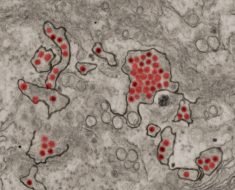A University of Adelaide-led team of scientists has suggested a potential link between iron in our cells and the rare gene mutations that cause Alzheimer’s disease, which could provide new avenues for future research.
In a paper published in the journal Frontiers in Neuroscience, the team proposes a new theory for how rare gene mutations cause Alzheimer’s disease. A theory that, if proven, could assist in finding a way to prevent the crippling disease.
The researchers caution people against making choices about diet or supplements based on this idea, as their theory only relates to how cells handle iron, not how much iron is in a person’s diet.
Background
“For 20 years most scientists have believed that a small protein fragment, amyloid beta, causes Alzheimer’s disease,” says Associate Professor Michael Lardelli, School of Biological Sciences, the University of Adelaide.
“Clearing out amyloid beta from the brains of people who are developing Alzheimer’s disease can slow their rate of cognitive decline. But, so far, nothing has been able to stop the relentless progression of the disease,” he says.
A chance conversation between Associate Professor Lardelli, Dr. Amanda Lumsden (South Australian Health and Medical Research Institute (SAHMRI) and Flinders University) and Dr. Morgan Newman (the University of Adelaide) was the inspiration for the new theory of how mutations might cause Alzheimer’s disease.
Dr. Lumsden has a background in the biology of how cells use iron, while the Adelaide researchers study the genes that cause Alzheimer’s disease when mutated.
After bringing their ideas to additional experts, such as Associate Professor Jack Rogers at Harvard Medical School and Dr. Shohreh Majd of Flinders University, this group of researchers has now published a paper suggesting their new theory for how mutations might cause the rare but devastating, early onset form of Alzheimer’s disease that afflicts some families.
The new theory
The team suggests that the abnormalities seen in inherited Alzheimer’s disease could result from problems in how neurons handle iron.
“Cells need iron to survive. In particular, iron is essential for the tiny powerhouses of all cells – the mitochondria – to generate most of the energy that keeps cells functioning,” says Associate Professor Lardelli.
“The genes mutated in inherited Alzheimer’s disease seem likely to affect how iron enters neurons, how it is recycled within neurons, and how it is exported from neurons.
“Since neurons have such huge energy needs, disturbing the way they handle iron can have serious, long-term consequences.
“Furthermore, iron is a key player in inflammation and in the production of damaging molecules named ‘reactive oxygen species’, and both occur at high levels in brains with Alzheimer’s disease,” says Associate Professor Lardelli.
Source: Read Full Article





